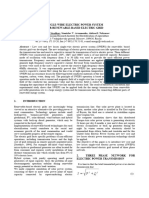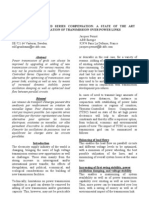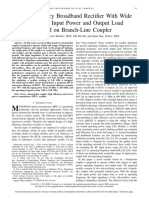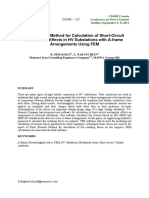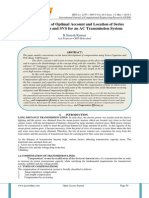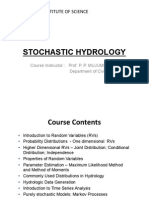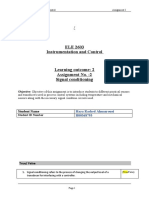0 ratings0% found this document useful (0 votes)
66 viewsShunt Compensation On Ehv Transmission Line
Shunt Compensation On Ehv Transmission Line
Uploaded by
kardraThis paper is to develop a program to determine the required shunt and Series Compensation on an EHV long transmission line.
Copyright:
© All Rights Reserved
Available Formats
Download as PDF, TXT or read online from Scribd
Shunt Compensation On Ehv Transmission Line
Shunt Compensation On Ehv Transmission Line
Uploaded by
kardra0 ratings0% found this document useful (0 votes)
66 views9 pagesThis paper is to develop a program to determine the required shunt and Series Compensation on an EHV long transmission line.
Original Title
45 Shunt Okok
Copyright
© © All Rights Reserved
Available Formats
PDF, TXT or read online from Scribd
Share this document
Did you find this document useful?
Is this content inappropriate?
This paper is to develop a program to determine the required shunt and Series Compensation on an EHV long transmission line.
Copyright:
© All Rights Reserved
Available Formats
Download as PDF, TXT or read online from Scribd
Download as pdf or txt
0 ratings0% found this document useful (0 votes)
66 views9 pagesShunt Compensation On Ehv Transmission Line
Shunt Compensation On Ehv Transmission Line
Uploaded by
kardraThis paper is to develop a program to determine the required shunt and Series Compensation on an EHV long transmission line.
Copyright:
© All Rights Reserved
Available Formats
Download as PDF, TXT or read online from Scribd
Download as pdf or txt
You are on page 1of 9
ISSN(Print):23203765
ISSN (Online): 2278 8875
International Journal of Advanced Research in Electrical, Electronics and Instrumentation Engineering
Vol. 2, I ssue 6, J une 2013
Copyright to IJAREEIE www.ijareeie.com 2452
SHUNT COMPENSATION ON EHV
TRANSMISSION LINE
N.Vijaysimha
1
, P.Suman Pramod Kumar
2
Assistant Professor , Dept. of EEE, CR.Engineering College, Tirupati, India
1
Associate Professor , Dept. of EEE, CR.Engineering College,Tirupati, India
2
ABSTRACT: This paper is to develop a program to determine the required shunt and series compensation on an EHV long
transmission line and after which, conduct a power system analysis using a power system simulation package to evaluate
the effect of compensations on the line with, To deter mine the shunt compensation at the load end to maintain the
load voltage at a fixed percentage of the sending-end voltage, the maximum power transfer limit that may be
transmitted under different conditions and to investigate the influence of various factors such as the line length,
load power factor and the degree of series compensation on the maximum power transfer capability. This paper
will commence with an overview of the problems encountered with an EHV long transmission line. This is followed up
by a literature review that covers the research of useful background theories. The results from the performed studies
and simulations will also be discussed in details.Finally, this paper will end with a conclusion of and recommendations for
future work in this area of research.
Keywords: Shunt compensation,Series Compensation,Transmission lines,Voltage,Power.
I.INTRODUCTION
The continuous increase of the voltage of transmission, line lengths and number of sub-conductors per
bundle has emphasized the importance of the excessive line MVAR in EHV systems as well as the associated voltage
and reactive controls. During line- charging volt-amperes of a line which have exceeded the inductive vars consumed and
operation at light loads, there is an undesirable voltage rises along the line. This voltage rise in turn demands a much higher
insulation level, which poses a great problem for the capacitive generator. Moreover, the problem is further deteriorated
when the var is necessary to flow to its maximum, causes transmission losses and take up equipment rating. It has
been proven that by using the series and shunt compensations are the best available methods because the
transmission distance can be reduced artificially and hence, more power can be transferred. The increase in the
interconnections of Extra High Voltage (EHV) systems with the increased demand for electrical power has elevated
concerns about system security and reliability.
II.SERIES COMPENSATION
There are two methods to achieve the increase in the maximum power transfer limit of the line. The first method
is to increase the transmission voltages. However, this will lead to an accumulating effect of cost increases in the
generator. The second method is by reducing the characteristic impedance of the line. The reduction of the
characteristic impedance of the line can be achieved either by changing the line dimensions or by addition of
capacitors in series with the line. The line dimensions cannot be changed widely and it only creates a small
impact on the characteristic impedance value. Therefore, the addition of capacitors in series with the line, also
known as the series compensation, is the best available method to reduce the characteristic impedance of the line, the
percentage of series compensation and the optimum location of series compensation will be studied. However, the
overview on the types of series capacitors, which could result in improving the system stability
Fig.1 Location of series compensation
ISSN(Print):23203765
ISSN (Online): 2278 8875
International Journal of Advanced Research in Electrical, Electronics and Instrumentation Engineering
Vol. 2, I ssue 6, J une 2013
Copyright to IJAREEIE www.ijareeie.com 2453
In Fig 1, a transmission line is divided into 10 equal sections and an equivalent model represents each
section. A lumped compensation can be placed at any locations marked 1 to 11 and a distributed compensation consists of
splitting the compensation from a range of locations, for example, from location 4 to 8 or location 1 to 11. In
comparison between these two types of series compensation, a lumped compensation gives a better result than a distributed
compensation from the point of view of obtaining the maximum power transfer, if the compensation is distributed, splitting
of the compensation into five equal parts and locating them at 30%, 40%, 50%, 60% and 70% of the line length from
receiving end, obtain the best results . To determine the required series capacitor in the transmission line of different degree
of series compensation, the value of Ks=40% and Ks=75% can be computed into a program function called series
compensation (ABCD), which is taken from . The results of the computation are shown below.
A. Percentage Compensation (Ks)
The percentage or the degree of series compensation is used to analyse a transmission line with the required
addition of series capacitor s. It is defined as the fraction of Xc, which refers to the total capacitive reactance of
series compensators and X
l
, which refers to the total inductive reactance of the line, as. K
S
=X
C
/ X
l .
Since the
objective is to determine the amount of series capacitor on the line, it will therefore be useful to define the
degree of compensation (Ks) in the total line impedance, which is Z=R+j [X
l
(1- K
S
)
B. Effect of Location of Compensation
The identification of the optimum location of the series compensation on the line is very important because
compensation at this location has been proven that it could obtain more economical loading and results in minimum loss
of revenue to the supply utility and minimum rise in receiving end voltage .
C.Performance of series capacitor-compensation under under-frequency conditions
Due to the lack of sufficient generating capability in developing countries, the
implementation of an under-frequency operation of the power system is accepted as a Strategy for
maintaining the continuity of supply. This is due to the fact that the Subnormal frequency
operation is associated with the reduced load demand, taking into Consideration of the frequency-
dependent characteristics of load .
Fig 2 Performance of compensated long line during under frequency operation Fig.3 Performance of compensated long line during under-
frequency operation
In Fig.2, it shows the result of an uncompensated line, b and a compensated line, during under-frequency operation
over a distance of 500km. The series capacitor located at the midpoint of the line may be objectionable from an
over voltage hazard point of view. For achieving maximum economy, the best location for a series capacitor is
at 45km from the sending end of a 500kV, 500km long transmission .Fig.3 illustrates the evaluation of compensation
with the changed power factor of system load, current delivered, active and reactive powers transfer red. At 45km from
the sending end of line retains the advantage of rise in active power transferred and maximum decrease in sending-
end cur rent during normal frequency operation.
ISSN(Print):23203765
ISSN (Online): 2278 8875
International Journal of Advanced Research in Electrical, Electronics and Instrumentation Engineering
Vol. 2, I ssue 6, J une 2013
Copyright to IJAREEIE www.ijareeie.com 2454
D.The Best Location and Percentage Compensation
For developing generalized curves to determining the best location and percentage of series compensation,
several lines which are specified by the values of R/X
L
and l/YX
L
, are used for studies. The best percentages
and locations of series compensation for these lines are shown in Fig 3.5 and Fig3.6. These two general curves are
useful in determining the best location and percentage series compensation of any transmission line of length about 1000km
for maximum power transfer.
Fig 4 Best percentage of series compensation Fig: 5 Best Location of series compensation with respect to %
with respect to % of line reactance of line length from receiving end
III.SHUNT COMPENSATION
Shunt reactors with their compensating effect on the capacitive generation of the line offer an economical and
technically sound means of controlling the undesirable over-voltage. This chapter will focus mainly on the over-
voltages under steady state condition and the effect of shunt reactors on such over-voltages. In many investigations of
determining the maximum power transfer, the amount of shunt reactors required on the transmission line is
defined as the degree of shunt compensation (Kd), where K
d
=B/Im{y}l K
d
is defined as the action of the total
inductive susceptance of shunt compensation, B and the total charging susceptance of line Im{y}l Regardless of where
the point of maximum voltage (with reactor) is located, the reactor mounted at the middle (point of maximum voltage without
reactor) of the line requires minimum reactor rating to bring the maximum voltage on the line within limit.When the reactor
(Y pu) is mounted at the middle of the line, the point of the middle voltage is no longer the centre of the line, as
shown in Fig 6. Under no-load condition, the reactor mounted at the line terminals has absolutely no control on the
voltage profile along the line under no-load condition
A.Shunt Capacitive Compensation
In order to avoid the phenomenon of SSR, some utilities have considered the use of shunt capacitive
compensation as an alternative means of increasing transmission capacity.One advantage claimed by shunt
capacitive compensation is that it is possible to maintain nodal voltage at nominal value through injection of reactive
power along the line. Another advantage is its capability to extend the steady state stability and improve dimpling when
used in conjunction with static VAR controllers.
B. Electrical System Model
Given the receiving-end voltage (VR), sending-end voltage (VS), real power (PR) and reactive power (QR)
at the receiving end of the line, the required capacitor Mvar at the receiving end for a specified load can be easily
computed. The Mvar value of the capacitor can be obtained by the definition given below Mvar=V
2
/X
c
Where X
c
=1/
c
Percentage of
series
compensation
ISSN(Print):23203765
ISSN (Online): 2278 8875
International Journal of Advanced Research in Electrical, Electronics and Instrumentation Engineering
Vol. 2, I ssue 6, J une 2013
Copyright to IJAREEIE www.ijareeie.com 2455
EXAMPLE:
Maintain the receiving-end voltage at a fixed percentage of the sending-end voltage
Fig.8 Shunt reactor at receiving end
This simple circuit can be used to find the amount of shunt reactor to maintain the receiving end voltage
at a specified value. With one reactor only at the receiving end, The voltage profile will not be uniform and the maximum
rises occurs at the midspan And the cur rent at the midspan is zero. This is illustrated in Fig 9.
C.Effect of Shunt and Series Compensations on Maximum Power Transfer
With the interconnection of power stations into power systems and power systems into power pools, transmission
lines should be capable of transmitting the maximum Possible energy when demanded. By using the series and
shunt compensations, the transmission distance can be reduced artificially and hence more power can be transferred.
These compensations are necessary to maintain a satisfactory voltage level when large block of power is transferred over a
long distance
Fig.9Voltage profile of compensated and uncompensated line
Fig.6 Mid-point voltage for different line lengths under
no-load condition
Fig.7 Voltage profile along 1,000 km line with different
reactors at the middle of the line under no-load condition
i
g
.
7
V
o
l
t
a
g
e
p
r
o
f
i
l
e
a
l
o
n
g
1
,
0
0
0
k
m
l
i
F
i
g
.
7
ISSN(Print):23203765
ISSN (Online): 2278 8875
International Journal of Advanced Research in Electrical, Electronics and Instrumentation Engineering
Vol. 2, I ssue 6, J une 2013
Copyright to IJAREEIE www.ijareeie.com 2456
.D.Transfer of Power on a long EHV transmission
Since a transmission line is operated with sources at both ends of the line, power can be derived in terms of
ABCD constants. Since A and B constants are related with the sending- end voltage(Vs ) and receiving-end
voltage(V
R
), the relationship could be expressed as
V
s
=AV
R
+BI
R
(5.1)
Solving for the receiving end current I
R
yields
Fig.10 Phasor of VR IR
*
plotted in the complex plane, with magnitudes and angles as indicated
Fig.5.1 shows the two complex quantities and their difference can be solved by the complex power V
R
I
R
* and
thus the real and reactive power at the receiving end respectively are written as
E.Classification of system buses
Slack bus makes up the difference between the scheduled loads and generated power that is caused by the losses in the
network. Load buses and regulated buses are also known as PQ buses and PV buses respectively. The unknown and
specified quantities of each bus is summarised in the table below.
Table :1 shows types of buses
F.Determine the Maximum Power Transfer
Fig11. Power diagram obtained by shifting the origin of the coordinate axes
ISSN(Print):23203765
ISSN (Online): 2278 8875
International Journal of Advanced Research in Electrical, Electronics and Instrumentation Engineering
Vol. 2, I ssue 6, J une 2013
Copyright to IJAREEIE www.ijareeie.com 2457
Fig. 11 shows that there is a limit to the power that can be transmitted to the receiving end of the line for
specified magnitudes of sending-end and receiving-end voltages. It is worth noting that as point K moves along the arc
towards until the angle =, more power is delivered. As increases, the lesser power is received. Hence, the
maximum power is
G. Determine the Critical Quantities
There are several ways to determine the maximum value of the receiving end Power, P
R,cri
from the basic
formula of receiving end power power which is given by
Where
Solving Eqn. 5.21, 5.22 and the load power factor, cos
Test Systems
In this paper two test systems are considered for load flow analysis viz., IEEE 14 Bus System and 30 Bus System.
IV. 14-BUS SYSTEM
From the information retrieved from the bus data of the 14-Bus System, Bus 2 is known to be the slack bus
and only Bus 9 has a shunt susceptance at the load end. Since the investigation of this thesis is restricted to
compensation at the receiving end of the line, therefore Bus 9 will be assumed to be the receiving-end system.
The sending-end systems that are connected to Bus 9 are namely Bus 10, Bus 4, Bus 7 and Bus 14. These transmission
lines that are connected to Bus 9 are selected for evaluation
ISSN(Print):23203765
ISSN (Online): 2278 8875
International Journal of Advanced Research in Electrical, Electronics and Instrumentation Engineering
Vol. 2, I ssue 6, J une 2013
Copyright to IJAREEIE www.ijareeie.com 2458
V. IEEE 30 BUS SYSTEM
VII.Comparison Of Compensated & Uncompensated Transmission Line
Enter sending end line-line voltage kV = 400
Enter receiving end voltage phase angle = 0
Series & Shunt Compensation
---------------------------
Vs = 400 kV (L-L) at 0
Vr = 420.669 kV (L-L) at -0.0026907
Is = 258.912 A at 89.8958 PFs = 0.00181784 leading
Desired no load receiving endvoltage with shunt compensation kV (L-L) =400
Desired no load receiving end voltage = 400 kV
Shunt reactance = 1830.01 ohm
Shunt rating = 87.4311 Mvar
VI. CONCLUSION
The comprehensive literature review has successfully covered the three main elements of the thesis, which
comprise of the long EHV transmission line, the shunt compensation and the series compensation. From the
background theories of these three elements, the optimum method of achieving the maximum power transfer in a
power system can be deter mined. The two modules of the thesis have emphasized on the ability of the shunt and series
compensation on a long transmission line. From the 14-Bus system and 30-Bus Systems, the results show how
influential the degree of series compensation (Ks) has on the power transfer capability. With the shunt compensation at
the receiving end, the load end voltage can be maintained at a percentage of the sending end voltage. Similar results
were obtained from the 14-Bus System and 30-Bus System. Therefore, one can say that the effect of shunt and series
compensation is universal on any system, regardless of how massive the power system design is. However, an
extensively huge power system will demand for more compensation schemes and the cost of the line will be enormous
In conclusion, the shunt compensation at the load end reduces the problem of over-voltages.
VIII. OUTPUT GRAPHS
Comparison between Compensated and Uncompensated Line Required shunt compensation
ISSN(Print):23203765
ISSN (Online): 2278 8875
International Journal of Advanced Research in Electrical, Electronics and Instrumentation Engineering
Vol. 2, I ssue 6, J une 2013
Copyright to IJAREEIE www.ijareeie.com 2459
Voltage profile Loadability Curves
graph b/n critical power and degree of series compensation
REFERENCES
[1].Indukar, C.S Required shunt compensation for EHV transmission line Power Engineering Review, IEEE Vol. 19, issue 9, sept.1999 p.p. 61-62.
[2] R. Rajarman, F. Alvarado, A. Maniaci, R. Camfield and S. Jalali, Determination of Location and Amount of Series Compensation to Increase
Power Transfer Capability, IEEE-Transactions-on-Power-Systems, Vol. 13, No. 2, May. 1998, pp. 294-300.
[3] C.S. Indulkar, K. Ramalingam & P.R. Bijw, Self Excited Oscillations in Series and Shunt Compensation Schemes of AC Transmission Systems,
International-Journal-of-Electrical-Power-&-Energy-systems, Vol. 19, No. 7, Oct. 1997, pp 481 - 488
[4] T.W. Kay, P.W. Sauer, R.D. Shultz, R.A. Smith, EHV and UHV line lodability dependence in var supply capability, lEEE Transactions on
Power Apparatus and Systems, PAS-101, No. 9, pp. 3569- 3575, September 1982
[5] A. Chakraborty & P. Sen,An Analytical Investigation of Voltage Stability of an EHV Transmission Network Based on Load Flow Analysis,
ISSN(Print):23203765
ISSN (Online): 2278 8875
International Journal of Advanced Research in Electrical, Electronics and Instrumentation Engineering
Vol. 2, I ssue 6, J une 2013
Copyright to IJAREEIE www.ijareeie.com 2460
Journal-of-he-Institution-of-Engineers-(India)-Electrical-Engineering-Division, Vol. 76, May. 1995
[6] K. Ramar & M.S. RaviprakashaDesign of Compensation Schemes Systems for Long AC Transmission Lines for Maximum Power Transfer
Limited By Voltage Stability, International-Journal-of-Electrical-Power-&-Energy-vol 17, No. 2, April. 1995, pp 83-89
[7]C.S. Indulkar, B. Viswanathan, Determination of shunt compensation for an EHV transmission line, IJEEE, Vol. 21, pp. 85-89, 1984.
[8]G.Joos and B.T.Ooi,Torsional Interactions between synchronous generators and long transmission lines,IEEE transactions on power
systems,vol.PWRS-2,no.1,Feb.1987,pp .17-24
[9]S.M.Chandekar and S.G Tarnekar Performance of Uncompensated and series capacitor- Compensated 500KV Long Transmission line Under
Subnormal Frequency conditions,IEEProceedings,Generation.Transmission.Distribution,Vol.145,No.3,May.1998,pp 315-319
[10]University of Washington Homepage, Power Systems Test Case Archieve, http://www.ee.washington.edu /research/pstca
[11] H. Saadat, Power System Analysis, McGraw Hill, Singapor e, 1999
[12]Powerworld World Simulator Homepage: PowerWorld Corporation, http://www.powerworld.com
BIOGRAPHY
N.VIJAY SIMHA, Prasently working as Assistant Professor of EEE in chadalawada
Ramanamma Engineering College,Tirupathi ,Andhrapradesh.He obtained his Masters Degree
from S.V.U. Engineering College,in 2010.His area of Interest are power system operation and
control, High Voltage Engineering ,generation of electric power.
P. SUMAN PRAMOD KUMAR, obtained his Bachleors degree from NBKR IST, Nellore
Dist & Masters Degree in 2005 from Bharath Institute of Higher Education & Research,
Chennai. Presently Working as Associate Professor of EEE in chadalawada Ramanamma
Engineering College,Tirupathi, Andhrapradesh. His area of interest are Control Systems,
Electrical Distribution System & High Voltage Engineering.
You might also like
- IEEE 33-Bus Test Distribution SystemDocument2 pagesIEEE 33-Bus Test Distribution Systemkardra86% (21)
- Tarns Mission Line Performance (No Load)Document6 pagesTarns Mission Line Performance (No Load)Mohamed Faisal75% (4)
- Automated Broad and Narrow Band Impedance Matching for RF and Microwave CircuitsFrom EverandAutomated Broad and Narrow Band Impedance Matching for RF and Microwave CircuitsNo ratings yet
- It Is Quite Another Electricity: Transmitting by One Wire and Without GroundingFrom EverandIt Is Quite Another Electricity: Transmitting by One Wire and Without GroundingRating: 4.5 out of 5 stars4.5/5 (2)
- Lab 3 Mapping Stock and Flow and Metal SimulationDocument10 pagesLab 3 Mapping Stock and Flow and Metal SimulationPard TeekasapNo ratings yet
- Load Flow Analysis of Transmission Network With Series CompensationDocument5 pagesLoad Flow Analysis of Transmission Network With Series CompensationInternational Journal of Research in Engineering and TechnologyNo ratings yet
- Optimizing Performance Parameters of Stationary Wire Free Power Transfer CircuitDocument13 pagesOptimizing Performance Parameters of Stationary Wire Free Power Transfer CircuitInternational Journal of Power Electronics and Drive SystemsNo ratings yet
- Effects of Series Capacitors in Transmission Lines: A. A. JOHJL& N-J.E. BarkleDocument3 pagesEffects of Series Capacitors in Transmission Lines: A. A. JOHJL& N-J.E. BarklehuamanahuiNo ratings yet
- EEE 1106 017 Impact of Series Compensation MHO Distance Relay in Algerian PDFDocument9 pagesEEE 1106 017 Impact of Series Compensation MHO Distance Relay in Algerian PDFostojic007No ratings yet
- Development of A Wireless Battery Charger For Dacia Electron EVDocument7 pagesDevelopment of A Wireless Battery Charger For Dacia Electron EVRoy RomanoNo ratings yet
- Template 3Document1 pageTemplate 3Ahmad Fajar FirdausNo ratings yet
- Practical Control of Switching Overvoltages by Switch-Sync Controller PDFDocument6 pagesPractical Control of Switching Overvoltages by Switch-Sync Controller PDFkaushikray06No ratings yet
- Power Improvement of Transmission Line U PDFDocument10 pagesPower Improvement of Transmission Line U PDFMuhammad Fahmi Syawali RizkiNo ratings yet
- Design of 230 KV Twin Bundle Double Circuit Overhead Transmission LineDocument4 pagesDesign of 230 KV Twin Bundle Double Circuit Overhead Transmission LineEditor IJTSRDNo ratings yet
- Reactive Power Compensation in 132kv & 33kv Grid of Narsinghpur AreaDocument10 pagesReactive Power Compensation in 132kv & 33kv Grid of Narsinghpur AreamichyimNo ratings yet
- Construction of Extra High Voltage Transmission Line Using MatlabDocument3 pagesConstruction of Extra High Voltage Transmission Line Using MatlabShreyaNo ratings yet
- Wired and Wireless Charging of EVDocument7 pagesWired and Wireless Charging of EVShubham RajNo ratings yet
- Protection of Series Capacitor CompensatDocument6 pagesProtection of Series Capacitor CompensatbashiNo ratings yet
- Single-Wire Electric Power SystemDocument8 pagesSingle-Wire Electric Power Systemstraw manNo ratings yet
- Series Compensation For A Hydro-Quebec Long Distribution LineDocument7 pagesSeries Compensation For A Hydro-Quebec Long Distribution LinejeffguitarNo ratings yet
- New Technology of Electric Power TransmissionDocument7 pagesNew Technology of Electric Power TransmissionTHE NIKOLA TESLA INSTITUTENo ratings yet
- Nps 4 BDocument6 pagesNps 4 BViacheslav LevkonyukNo ratings yet
- Performance of Short Transmission Line Using Mathematical MethodDocument8 pagesPerformance of Short Transmission Line Using Mathematical MethodInternational Journal of Application or Innovation in Engineering & ManagementNo ratings yet
- Evaluating The Effect Placement Capacitor and Distributed Photovoltaic Generation For Power System Losses Minimization in Radial Distribution SystemDocument7 pagesEvaluating The Effect Placement Capacitor and Distributed Photovoltaic Generation For Power System Losses Minimization in Radial Distribution SystemMuhammad Khoirul Ilham Al-farashiNo ratings yet
- PT Cep Hardware 3Document8 pagesPT Cep Hardware 3Memer XYZNo ratings yet
- Analysis of TCSC For Improving Power System Stability & EconomyDocument13 pagesAnalysis of TCSC For Improving Power System Stability & EconomyBelayneh TadesseNo ratings yet
- Transient Performance For A Series-Compensation in A High Voltage Transmission SystemDocument10 pagesTransient Performance For A Series-Compensation in A High Voltage Transmission SystemKiran KumarNo ratings yet
- Microgrid Power Quality Enhancement Using A Three-Phase Four-Wire Grid-Interfacing Compensator PDFDocument13 pagesMicrogrid Power Quality Enhancement Using A Three-Phase Four-Wire Grid-Interfacing Compensator PDFVamshi KrishnaNo ratings yet
- 10 1016@j Ijepes 2006 09 005 PDFDocument13 pages10 1016@j Ijepes 2006 09 005 PDFAnonymous i5mi6hzYuTNo ratings yet
- Prototype of 5.8 GHZ Wireless Power Transmission System For Electric Vehicle SystemDocument5 pagesPrototype of 5.8 GHZ Wireless Power Transmission System For Electric Vehicle SystemCyberJournals MultidisciplinaryNo ratings yet
- Basic Experimental Study On Helical Antennas of Wireless Power Transfer For Electric Vehicles by Using Magnetic Resonant CouplingsDocument5 pagesBasic Experimental Study On Helical Antennas of Wireless Power Transfer For Electric Vehicles by Using Magnetic Resonant CouplingsjNo ratings yet
- Impedance Transformers: Vitaliy Zhurbenko, Viktor Krozer and Tonny RubækDocument21 pagesImpedance Transformers: Vitaliy Zhurbenko, Viktor Krozer and Tonny RubækraktimguhaNo ratings yet
- Application of Fuzzy Logic For Loss Reduction in A Transmission NetworkDocument22 pagesApplication of Fuzzy Logic For Loss Reduction in A Transmission NetworkOhanyelu Okeoma DanielNo ratings yet
- Synthesis of Lumped Transmission-Line AnalogsDocument13 pagesSynthesis of Lumped Transmission-Line AnalogsIulius LucaNo ratings yet
- Analysis of The Short-Circuit Capacity of Power Systems Considering Changes in Network TopologyDocument9 pagesAnalysis of The Short-Circuit Capacity of Power Systems Considering Changes in Network TopologyTerry García GNo ratings yet
- High-Efficiency Broadband Rectifier With Wide Ranges of Input Power and Output Load Based On Branch-Line CouplerDocument9 pagesHigh-Efficiency Broadband Rectifier With Wide Ranges of Input Power and Output Load Based On Branch-Line CouplerAesha MarshoudNo ratings yet
- Ehvac To HvacDocument5 pagesEhvac To HvacInsaf MohamedNo ratings yet
- 05IPST087 Paper PDFDocument6 pages05IPST087 Paper PDFWilliam AriasNo ratings yet
- Modelling of OHL and UG PDFDocument6 pagesModelling of OHL and UG PDFCarlos Lino Rojas AgüeroNo ratings yet
- 1 5002033 PDFDocument9 pages1 5002033 PDFDmk ChaitanyaNo ratings yet
- A Review On Reactive Power Control in Transmission Line Using Various MethodsDocument4 pagesA Review On Reactive Power Control in Transmission Line Using Various MethodsPriyanshi PatelNo ratings yet
- WCE2009 pp411-416Document6 pagesWCE2009 pp411-416Soumyadip GhoshNo ratings yet
- WIRELESS POWER - Minimizes Interconnection ProblemsDocument4 pagesWIRELESS POWER - Minimizes Interconnection ProblemsmegustalazorraNo ratings yet
- High Frequency Transformers For DC-DC ConvertersDocument6 pagesHigh Frequency Transformers For DC-DC ConvertersÄlî VàráNo ratings yet
- A Method For Power Conditioning With Harmonic Reduction in MicrogridsDocument6 pagesA Method For Power Conditioning With Harmonic Reduction in MicrogridsINder DǝǝpNo ratings yet
- An Injection LockedDocument11 pagesAn Injection LockedMANNE SAHITHINo ratings yet
- High Voltage LinesDocument7 pagesHigh Voltage LinesvelisbarNo ratings yet
- Engineering Method For Calculation of Short-CircuitDocument7 pagesEngineering Method For Calculation of Short-CircuitnicklionsNo ratings yet
- IET Generation Trans Dist - 2021 - Challa - An Algorithm For Fitting Passive Equivalent Circuits For Lumped ParameterDocument14 pagesIET Generation Trans Dist - 2021 - Challa - An Algorithm For Fitting Passive Equivalent Circuits For Lumped Parameterjosdebakker7No ratings yet
- Enhancement of Power System Security With Contingency Technique by Using SSSCDocument7 pagesEnhancement of Power System Security With Contingency Technique by Using SSSCEngidaw Abel HailuNo ratings yet
- 3.7 Fan Public Version 2012Document6 pages3.7 Fan Public Version 2012Aakash SheelvantNo ratings yet
- Hadi Saadat - Power System-Chapter 4 .Document42 pagesHadi Saadat - Power System-Chapter 4 .RASHEED MUHAMMADNo ratings yet
- Determination of Optimal Account and Location of Series Compensation and SVS For An AC Transmission SystemDocument8 pagesDetermination of Optimal Account and Location of Series Compensation and SVS For An AC Transmission SystemInternational Journal of computational Engineering research (IJCER)No ratings yet
- Jorunal Research GRADocument5 pagesJorunal Research GRAmoney heistNo ratings yet
- 32 Paper 60Document5 pages32 Paper 60shankul.saurabhNo ratings yet
- High Phase Order Transmission System: "A Solution For Electrical Power Transmission in Deregulated Environment"Document9 pagesHigh Phase Order Transmission System: "A Solution For Electrical Power Transmission in Deregulated Environment"IJERDNo ratings yet
- TD NOV Dec 2013 SolvedDocument21 pagesTD NOV Dec 2013 SolvedjothipriyagNo ratings yet
- Performance of Line (Power System)Document12 pagesPerformance of Line (Power System)EE-053-Nirmal TuduNo ratings yet
- Low Frequency AC Transmission SystemDocument10 pagesLow Frequency AC Transmission SystemchaitanyaNo ratings yet
- A Methodology For Making A Three-Coil Wireless Power Transfer System More Energy Efficient Than A Two-Coil Counterpart For Extended Transfer DistanceDocument10 pagesA Methodology For Making A Three-Coil Wireless Power Transfer System More Energy Efficient Than A Two-Coil Counterpart For Extended Transfer DistancephithucNo ratings yet
- Transmission Line Transposition On ATPDrawDocument4 pagesTransmission Line Transposition On ATPDrawRogerio Lucena100% (1)
- Oliver Grasl-Business Model DynamicsDocument48 pagesOliver Grasl-Business Model DynamicskardraNo ratings yet
- Pareto Distribution: X and 0, 0Document6 pagesPareto Distribution: X and 0, 0kardraNo ratings yet
- Interactive Protection Using ATP Models PDFDocument6 pagesInteractive Protection Using ATP Models PDFCarlos Lino Rojas AgüeroNo ratings yet
- Stochastic Hydrology: Indian Institute of ScienceDocument40 pagesStochastic Hydrology: Indian Institute of SciencekardraNo ratings yet
- Diana Fisher-Keynote TeachSDModelDocument39 pagesDiana Fisher-Keynote TeachSDModelkardraNo ratings yet
- 1 KinerosDocument117 pages1 KineroskardraNo ratings yet
- IEEE 30 Bus Distribution SystemDocument5 pagesIEEE 30 Bus Distribution Systemkardra100% (1)
- Component Modeling: Power System StructureDocument3 pagesComponent Modeling: Power System StructurekardraNo ratings yet
- 14 Kalak KanawiDocument21 pages14 Kalak KanawikardraNo ratings yet
- Subscripting in Vensim 2 - Introducing, Progressing Between, Mapping and Creating Subranges of SubscriptsDocument41 pagesSubscripting in Vensim 2 - Introducing, Progressing Between, Mapping and Creating Subranges of SubscriptskardraNo ratings yet
- 123 Bus DataDocument7 pages123 Bus Datakardra100% (2)
- Supplemental Lecture - Sensitivity AnalysesDocument23 pagesSupplemental Lecture - Sensitivity AnalyseskardraNo ratings yet
- TREND User GuideDocument29 pagesTREND User GuidekardraNo ratings yet
- Regional Ow-Duration Curves: Reliability For Ungauged BasinsDocument13 pagesRegional Ow-Duration Curves: Reliability For Ungauged BasinskardraNo ratings yet
- Simulation Lab ManualDocument20 pagesSimulation Lab ManualShashikant PatelNo ratings yet
- Transformer SFRA Application Note - Sister TransformersDocument26 pagesTransformer SFRA Application Note - Sister TransformersJorge MoralesNo ratings yet
- physicsDocument37 pagesphysicskurinjikothai0501No ratings yet
- Effect of Power Swing On The Performance of Mho RelayDocument51 pagesEffect of Power Swing On The Performance of Mho Relaysubhankar dash50% (4)
- Elex 1Document4 pagesElex 1Joshua DoctorNo ratings yet
- 2016-17 K Tam GB v1b PDFDocument140 pages2016-17 K Tam GB v1b PDFhjayekoue01No ratings yet
- Transmisson Line Protection Using Static Impedance Relay: Mr. Nilesh Pangare, Mr. R. S. DesaiDocument5 pagesTransmisson Line Protection Using Static Impedance Relay: Mr. Nilesh Pangare, Mr. R. S. DesaierpublicationNo ratings yet
- Itt - (J+L) TI.v (T-JT) J: (Half Short-Circuits) .) )Document8 pagesItt - (J+L) TI.v (T-JT) J: (Half Short-Circuits) .) )Luisa De CairesNo ratings yet
- Mastering Electrical Engineering P. 1-3Document99 pagesMastering Electrical Engineering P. 1-3Gourab DebnathNo ratings yet
- Sensors 19 01273 PDFDocument16 pagesSensors 19 01273 PDFRitesh SadwikNo ratings yet
- Network Theory Question Bank Unit-I JNTU SYLLABUS: Three Phase CircuitsDocument19 pagesNetwork Theory Question Bank Unit-I JNTU SYLLABUS: Three Phase CircuitsmahendrachjoshiNo ratings yet
- AC Tech SCF SeriesDocument67 pagesAC Tech SCF SeriesRodrigoNo ratings yet
- Adaptive Distance Protection For Lines Connecting Converter-Interfaced Renewable PlantsDocument11 pagesAdaptive Distance Protection For Lines Connecting Converter-Interfaced Renewable PlantsPratikKumarNo ratings yet
- MHW1815 MHW1915 Modificat..Document10 pagesMHW1815 MHW1915 Modificat..Constantinos VaidanisNo ratings yet
- Module 3 QsDocument44 pagesModule 3 QsSatishReddy100% (1)
- ECT Level 3Document66 pagesECT Level 3rf85ahmadi100% (1)
- ELE 2603 AssignmentDocument16 pagesELE 2603 AssignmentハヤNo ratings yet
- Short Circuit Current CalculationDocument5 pagesShort Circuit Current CalculationIdham A. DjufriNo ratings yet
- Hubert Exercises Chapter Nine SG PDFDocument4 pagesHubert Exercises Chapter Nine SG PDFJulian GarciaNo ratings yet
- Antenna Power DividerDocument2 pagesAntenna Power DividerStephen Dunifer100% (2)
- Concepts of Signal Integrity: Impedance: Mentor, A Siemens BusinessDocument12 pagesConcepts of Signal Integrity: Impedance: Mentor, A Siemens BusinessAnh Viet NguyenNo ratings yet
- Valvula ExpansionDocument20 pagesValvula ExpansionTomas VargasNo ratings yet
- Protection Automation Application Guide v1 - Compressed (501 514)Document14 pagesProtection Automation Application Guide v1 - Compressed (501 514)Achraf RGUIGNo ratings yet
- 150+ IES Electrical Questions With Answers For IES 2014Document42 pages150+ IES Electrical Questions With Answers For IES 2014Jay Prakash PatelNo ratings yet
- Lecture 3Document22 pagesLecture 3MUHAMMAD ZUBAIRNo ratings yet
- Active Filter IEEEDocument13 pagesActive Filter IEEEAgustin WolyniecNo ratings yet
- Electromagnetic Theory & Transmission Lines: Maulana Abul Kalam Azad University OF Technology, West BengalDocument7 pagesElectromagnetic Theory & Transmission Lines: Maulana Abul Kalam Azad University OF Technology, West Bengalsomething creativeNo ratings yet
- A Design of Microstrip Directional Coupler For High Directivity and Tight CouplingDocument4 pagesA Design of Microstrip Directional Coupler For High Directivity and Tight CouplingKamaraj PandianNo ratings yet
- I. Objectives: Figure1. A Typical Bridge CircuitDocument6 pagesI. Objectives: Figure1. A Typical Bridge CircuitThảo Nguyễn PhươngNo ratings yet
- GeheDocument8 pagesGehejsg2407No ratings yet


















